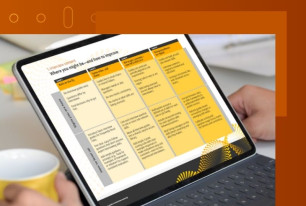On the Sofa with Emma Payne: How SHL Manages Hiring
SHL’s Head of Talent Acquisition, Emma Payne, talks about how SHL manages hiring internally and externally, and why candidate experience can make a difference.
Share
In the last of our series of blogs with SHL’s HR Leaders, we hear from Emma Payne, Head of Talent Acquisition, about how SHL manages hiring, why candidate experience matters, and the challenges in hiring.
Could you describe your responsibilities as Head of Talent Acquisition?
I have been with SHL now for nearly 5 years and I joined with the remit to build a talent acquisition center of excellence, with the purpose of delivering external and internal hiring in an environment of fast-paced transformation and growth. The focus has been on developing and implementing effective talent acquisition plans which can vary by region. We coach our people leaders to identify what skills are missing from the team, but cultural additions are needed to support a high-performing team to deliver our business goals.
What are the main challenges you see on a day-to-day basis?
Much has been said about the ‘Great Resignation’ and the increased competition for talent, and it is no different at SHL. Hence, it is important to make ourselves an attractive place to work and provide an excellent candidate experience.
Our team has a good working partnership with our HR business partners to understand strategic requirements, succession planning, future-proofing against attrition, and anything else that could impact hiring in the short or long term so we can plan accordingly. This is critical as my team works on building a talent pipeline in those key areas and enabling us to be less reactive and more proactive to hiring demands.
We are seeing more companies counteroffer or hold exiting employees to their notice periods, and we do not want the business waiting for someone. We know it can take someone up to 6 months to be productive.
How do you go about sourcing the right candidates for each role?
In today’s market, skill shortage means we need to identify specific sourcing strategies that focus on potential, transferrable skills, and internal talent pool. In some regions, SHL is not a well-known brand. We work on increasing our employer brand through social media platforms. We have created a series of employee spotlights that highlight career progression, work-life balance, and women in tech.
We encourage employees to be brand ambassadors and coach our people leaders that the hiring process is just as much about us learning about the candidate but also for them to learn about us and our ways of working. We have been particularly thoughtful about our candidate experience during the hiring process aiming to ensure it is a minimum of bias and fair to all—at the application stage on our job adverts, we ask if people need reasonable adjustments to the hiring process to make it as open as possible. We have committed to advertising all our open roles internally first then using multiple ways to extend our reach out to talent such as an employee referral scheme, LinkedIn, and our career site to ensure we are extending our reach to diverse talent pools globally. We will shortly be live on the BYP Network website as we know there is work to be done in supporting our black community.
What is the typical hiring process a candidate goes through?
As a global organization, we need a process that can fit across regions, be consistent, and provide the right data for a hiring manager to make an informed hiring decision. Our hiring process typically has 3 main stages—initial screening, assessment, and a two-stage interview process.
Everybody who applies is first screened by someone on our team to check things like the right to work in that specific country or certain qualifications that are required.
We have the benefit of our full suite of talent acquisition solutions and have worked with our science team to map our assessments to job roles so we can accurately measure the competencies that each requires while making sure we are always running a fair and equitable process. Then we can add other solutions as needed if we are focusing on technical hiring, for example.
The assessment is the one element of the hiring process that we move around so it could be at different stages in the hiring process—the reason for this is candidates may have engaged with our brand in different ways so passive candidates, which means those who are not actively looking for a new role but have been contacted by a recruiter, would not be given an assessment immediately as they have only just shown some interest so we would want to engage them further with our company and brand first.
For internal applications, we have the benefit of already seeing those high potentials and reusing existing data to help make decisions, but it is still important to have them take part in the same process as they still might learn about different areas of the organization or meet new people they have not encountered before.
During our interviews, we normally have the candidate speak with a minimum of three individuals who are relevant to the role. This allows us to give a broad representation of our company by getting a split of genders, ethnicities, etc., and gives both candidates a good indication of who their colleagues are, as well as from our side having a range of views to reduce unconscious bias. The structure of the interview is aimed to be a two-way conversation, using assessment insights to help identify areas to discuss and some type of presentation or competency-based questions depending on the role.
We have been particularly thoughtful about our hiring process to make sure it is a minimum of bias and fair to all.
What is the decision-making process to decide the successful candidate and how do you measure success?
In terms of decision-making, as we are not speaking about high-volume hiring here, we do not use the assessment as a filtering method—we combine it with all the other elements such as the screening, competency interview, and feedback from panel assessments, then take a holistic view of what candidates move down the funnel. The final decision rests with the hiring manager, as HR partners, we provide all the supporting information needed to help this decision.
Like any other part of the business, we have KPIs, and I have set some for our team. The source of hire is one of them to help promote from within but also from direct sources and not rely on external hiring where possible. We look at metrics such as time spent on our careers site, drop-out rates, and engagement throughout the different elements of our hiring process so we can optimize where needed. Then there are more data-driven things like accuracy of data inputted into our HCM (Human Capital Management) system, speed of hire, and DEI (Diversity, Equity, Inclusion) targets so there is a lot we can and do measure to help us become as efficient as possible while ensuring our processes remain objective and aligned with the business goals.
What is your view on candidate experience?
Even the most recognizable brands like Apple or Google position the reasons why you should work for them as part of their candidate experience. For companies with lower brand awareness and high competition for candidates, candidate experience is often what makes them stand out and become an employer of choice.
I focus on keeping us up to date with market information as much as I can to ensure we are ahead of or at least working towards better engagement and knowing what matters to candidates so we can be an employer of choice. For example, through using our platform, every individual who completes an assessment during our process receives a candidate report to provide feedback to guide their career.
The hiring team and our team are very much brand ambassadors. We are typically the first interaction someone has with the business, so we have an important part to play in giving a good impression and ensuring candidates know what the company stands for, its values, and why it is a great place to work. Part of that external branding is celebrating employees, giving them a spotlight, and asking new hires to share their hiring experiences to show that we are completely transparent about our hiring process.
See how you can improve your hiring processes and use an objective, data-led approach to get the right people into your organization with SHL.










